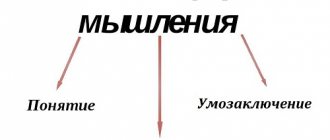Thinking in general is the ability of the human psyche to fully reflect reality, objects, phenomena, as well as significant connections between them. This is a typical feature of the human mind that is the result of long evolutionary changes. The possibility of mental activity allows you to effectively engage in a variety of forms of activity: from cognitive to creative, transformative.
Abstract thinking is the main form of cognitive abilities and plays the greatest role in the use of logic, formal logic, and its other forms, cognitive activity, studying the world around us and describing it in the form of consistent concepts.
What does abstract thinking mean? In simple words, it means the ability to describe objects and phenomena in a generalized form, using special conditional tools. That is, concepts. Determine the connections between them through judgment. Isolate new knowledge from already known premises through inferences. These are the most powerful ones capable of determining the truth, systematizing the world in all its diversity using standard mental operations. Such a possibility is present only in humans, as an intelligent species.
The lack of developed abstract thinking is considered normal until a certain age. The active formation of abstract theoretical thinking occurs in the period from 5 to 12-13 years. At this time, a person learns to operate with formal, abstract categories and fully understand their essence. The rate of development varies from person to person. You can develop the ability to think this way at any age; there is a group of exercises.
What is abstract thinking?
Abstract thinking is the operation of abstract concepts. These include concepts that do not correspond to specific objects or phenomena. These can be generalizations (man, animal, dog), as well as various concepts that receive their meaning directly in the process of thinking or discussion (number, morality, matter).
In dialectical logic, the abstract is opposed to the concrete. For example, you can talk about a specific dog, or you can talk about a dog or an animal in general - this is already an abstraction. You can say that the weather outside today is bad - rain and thunderstorms, or you can talk about the weather as a phenomenon in general.
To properly understand what abstract thinking is, it is important to understand the meaning of the terms “abstraction” and “abstraction.” Abstraction is a distraction from part of the properties of an object. For example, in painting, this implies that the artist discards some of the visual properties of characters and objects in order to emphasize other properties and convey certain emotions. Abstraction is the very process of generalization and simplification, discarding specific details that are irrelevant in the current context.
Abstract thinking allows us to think about various objects and phenomena without specifying their properties. Using it, we can imagine and comprehend a certain situation without formulating what is happening in words and without recreating any images in our thoughts. Being the fastest way of thinking available to us, it is this that allows us to quickly find extraordinary ways to solve the problems that arise before us.
Types of abstractions
A man says he misses a woman - what does that mean?
The classification of types of abstraction is based on the purposes of this operation :
- Isolating abstraction. A specific phenomenon is isolated from the general background and studied. For example, there is an orange on the table. A person identifies two characteristics from it: orange color and sweet-sour taste. Such an abstract (this is a construct formed in the process of abstraction) allows us to further compare it, for example, with tangerines.
- A generalizing abstraction is necessary to obtain a general image, for example, to create a theoretical or empirical model of research. An example is mathematical equations that are solved as a whole, without breaking them down into components.
- Idealization is needed to create an ideal picture of the phenomenon being studied to achieve certain research or practical goals.
The purpose of abstraction for performing a certain class of mental operations may vary, but it is always associated with a specific task and its inclusion in the broader context of cognitive activity.
Differences from “concrete” thinking
Abstract and concrete thinking can be considered opposites of each other. The first is aimed at conceptualization and generalization, while the second specifies an object or phenomenon and attaches fundamental importance to it or its properties.
Concrete or concrete-object thinking appears at the age of 18 months and develops until approximately 7 years. Using it, the child can solve problems using specific objects and their images. At the same time, he is not able to be distracted from real objects; abstract concepts and categories are inaccessible to him.
Abstract or abstract-logical thinking appears in a child around the age of 7, after which it develops as his personality develops. Together with it, he gains the ability to operate with categories that do not exist in real nature in the form of specific objects or phenomena.
Examples of abstract thinking
The most obvious example of abstract thinking is mathematical operations. You can use mathematics in real life by counting or measuring specific objects and phenomena. But at the same time, we can completely abstract from reality using abstract meanings.
For example, everyone understands perfectly well what the number 10 means, even if we are not talking about 10 specific objects. In addition, mathematical operations are abstract. We can add, divide, multiply and subtract without referring to any specific objects.
A less obvious, but much more extensive example is the language of our communication. It consists of a huge number of abstract lexical units, most of which are in one way or another compared with real objects and phenomena, but in conversation they are not always tied to something specific. The sentences that we use in speech are abstract logical chains of lexemes that our interlocutor can understand and interpret quite unambiguously.
Forms of abstract thinking
Abstract thinking can take three forms: concept, judgment and inference. Usually, when thinking abstractly, a person consistently uses all three forms. Let's look at each of them in more detail.
- Concept. This is a generalized abstraction that describes a specific object or phenomenon, but does not indicate a specific object or event. Examples of concepts: person (an abstract person, not a concrete individual), house, dog
- Judgment. This is a certain statement containing information about the property of a certain object. Judgments are divided into true and false, as well as simple and complex. A simple statement indicates a single fact, while a complex statement may describe a pattern or cause-and-effect relationship. For example, the proposition “The grass is green” is simple and true, while the proposition “We don’t slide off the Earth because it is flat” is complex and false.
- Conclusion. An inference is a new judgment formulated on the basis of several others. It is the result of rational knowledge (that is, it was not obtained empirically). An example of an inference based on two judgments: “In the morning there were candies in this vase” + “Now the vase is empty” → “Someone ate all the candies.”
Essence and benefits
So, the ability to think helps a person build his own views on the world around him, cope with life’s difficulties, and achieve goals. But in most cases we use the exact variety, operating with detailed data.
When we see a guy sitting on a bench and cracking sunflower seeds, it seems to us that he is a slacker. That is, we think based on the specifics that are in front of us. But we can do this more generally, and then we will learn much more.
Stepping away from the facts and assuming context, we understand that perhaps the young man had a fight with his girlfriend, and before that he had given up smoking and therefore replaces the cigarette in a similar way. Or today he has a free day and he decided to relax and get some fresh air. Abstract thinking gives us room for imagination, to look at what is happening from different points of view and to learn a lot of interesting things.
This method is especially useful in specific everyday events when a person finds himself in an intellectual dead end. That is, she finds it difficult to find a solution to a problem or develop an objective view. But abstraction allows you to notice what was not so obvious before.
What are the benefits of abstract thinking?
Abstract thinking is the source of creative ideas, which are needed in almost every profession. Creativity allows you to come up with ideas for new projects, find unusual solutions to problems, select tools for yourself and create new ones. A creative approach is useful in all areas of life, and it relies primarily on the ability to think abstractly.
Developed abstract thinking provides such advantages as:
- ability to solve complex problems;
- high level of intelligence;
- high level of creativity;
- a penchant for various arts;
- the ability to go beyond stereotypes;
- ability to generate new ideas;
- ability to predict and evaluate project prospects;
- ability to spot potential pitfalls.
How to develop abstract thinking?
As we have already found out, the ability to think abstractly is very important, so any person should work to develop it. Like other cognitive abilities, abstract thinking develops through active use. To do this, you can perform 5 simple but effective exercises:
- Understanding an abstract object or phenomenon. Each of us constantly operates with various abstract concepts, for example, such as “love”, “friendship”, “respect” and so on. A very good exercise for developing the ability to think abstractly is to try to understand what each of these abstract concepts is. You need to comprehend them and define them in simple and understandable words.
- Association game. Children love to play this game, or rather, they do it involuntarily. Looking at the clouds, they recognize familiar images in them. They can tell you what a car parked on the side of the road looks like, what shape a tree is, what a vacuum cleaner or washing machine sounds like. Children do this involuntarily because they are exploring the world and everything that surrounds them arouses their interest. But adults should also play this game more often, trying to recognize familiar images in the outlines of objects, look for associations to certain sounds, try to understand what the taste of a particular dish is like.
- Development of imaginative thinking. Abstract-logical thinking largely depends on figurative thinking. Therefore, for its development it is useful to actively use the ability to think in images. To do this, you can remember the events that happened during the day, trying to restore in your imagination visual images, voices and other sounds, experienced emotions, smells and tastes. In this case, detail is important. For example, when remembering someone’s face, it is advisable to clearly imagine the shape of the nose, eyes and other details.
- Using metaphors. In order to come up with a good metaphor, you need developed abstract thinking. And it can be developed using this feature. To do this, it is useful to read fiction, which often contains interesting and unexpected metaphors. It is also useful to apply them in everyday communication, trying, of course, to make it look appropriate. However, if you are not sure of the quality of the invented metaphor, it is not at all necessary to voice it.
- Finding the essence. It is very useful to get to the bottom of various events, phenomena and even your own actions. To do this, you can ask yourself questions about everything that surrounds us. Examples of questions: “Why does this thing have this particular shape?”, “Why do I do this work this way? Shouldn't I do it differently?", "What will be the result of my actions? Is this exactly what I need?”, “Can I simplify my work to achieve the same result with less effort?”. Finding answers to questions like these will not only help develop abstract thinking, but can also make life much easier.
Methods for checking the degree of development of cognitive abilities
Checking the degree of development of abstract thinking does not present much difficulty. Psychologists also deal with it. How exactly can abilities be explored? The following group of tests is used:
- The standard test for abstract thinking is the Eysenck test. Allows you to explore intellectual capabilities. Additionally, other tests may be used, depending on the situation.
- The abstract-verbal style of thinking can be assessed based on the results of a conversation with a person. Additionally, a situation or topic may be presented, on which the subject must draw conclusions. This will provide more information than a simple oral interview.
- It is possible to use special logical tasks. They allow you to study the speed of abstract thinking, its quality, direction, and the ability to quickly switch from task to task, from process to process.
A person can check himself. However, it is better when an experienced psychologist is involved in the case.











